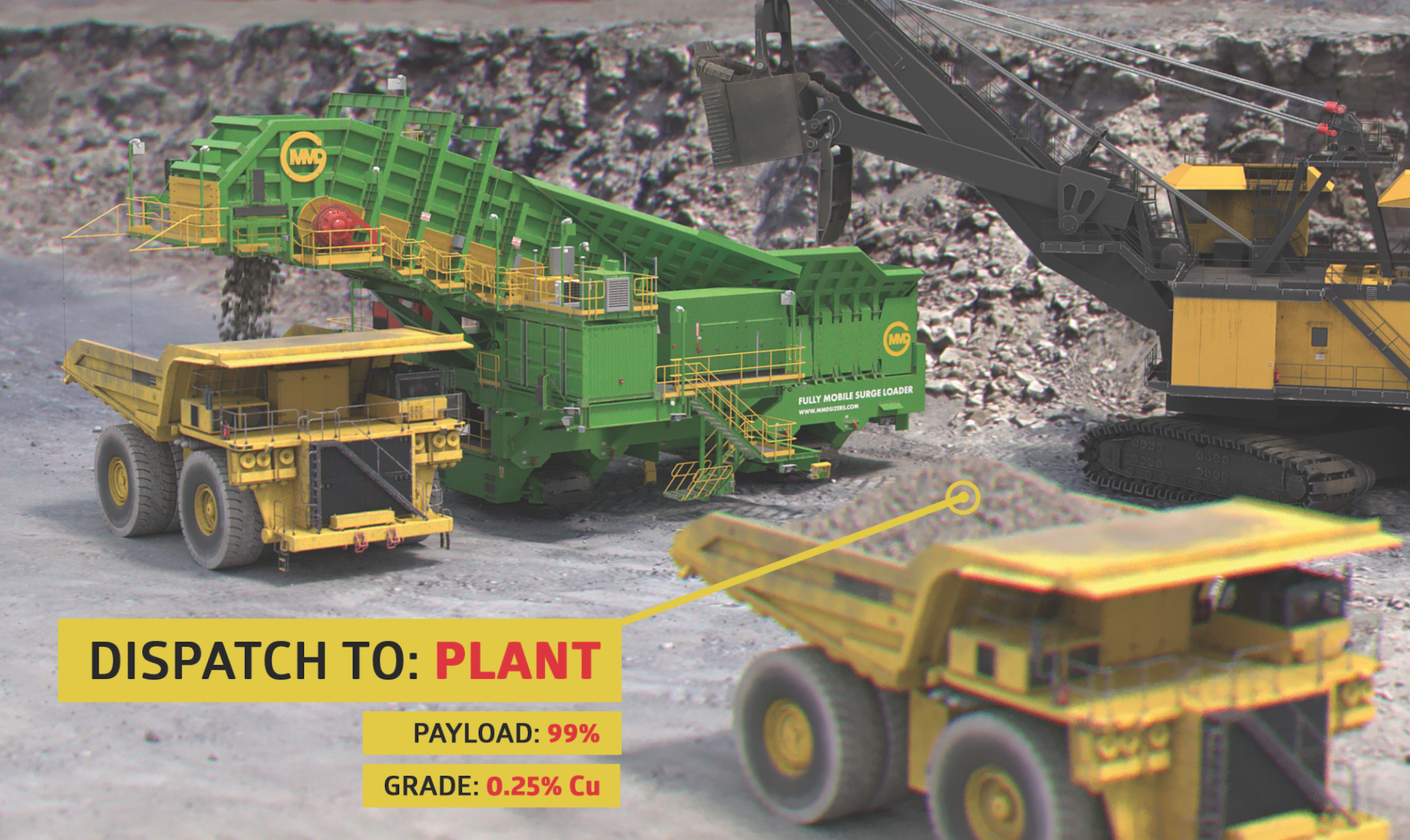IM sat down with MMD at The Electric Mine 2023 for an exclusive update on its Fully Mobile Surge Loader or FMSL – its innovative in-pit solution that acts as a mobile storage bunker between the shovel and a continuous flow of trucks. It has been proven capable of an average fill rate of less than 60 seconds for a 330 t class truck.
As trucks approach the FMSL they are identified by RFID and guided into the optimum loading position. The FMSL hopper reception provides a generous target for the shovel to dig, spot and load continuously, thereby optimising swing angle and load cycle times – in short truck and shovel cycles get a lot more repeatable and efficient. Simulations have shown its potential to deliver up to 40% improves truck and shovel system performance, up to 95% shovel utilisation and up to 98% average target payload.
MMD FMSL operating at a major US copper mine

The first unit has shown impressive results so far at a major US copper mine, with performance data set to be released in due course. However, suffice to say that it is delivering the expected benefits of almost eliminating non-productive truck spotting time. Furthermore, the FMSL’s consistent loading of diesel trucks within 3% of target payload is also delivering many benefits, such as reduced GHG emissions, fuel consumption and associated costs. Looking ahead, battery driven truck fleets with their increased sensitivity to load variance, can also greatly benefit from the FMSL’s consistent payload delivery by improving their productivity and haulage capabilities. Autonomous haulage systems deliver even further potential for efficiency. The FMSL is already intelligent and autonomous so combining this with AHS trucks will be relatively straightforward.
But the focus of the discussion was the huge potential to combine the safety and throughput capabilities of the FMSL with sensor-based ore analysis. MMD is arguably already the most experienced company in the world in terms of bulk ore sorting – with installations running at a copper mine in Chile, a platinum mine in South Africa, and a nickel mine in Brazil. The largest of these handles 1,000 t/h, albeit MMD have systems designed for more than 5,000 t/h but a sensor system working on the FMSL apron feeder would be another level – up to 20,000 t/h and above using a D10 type Apron Plate Feeder.
The approach to sensors on the existing bulk ore sorters was agnostic and remains so – combinations of PGNAA, XRF and PFTNA technology have been used in these installations, with the exact nature of the set-up varying between ore types and very much based on trials.
And the same approach will be used for the FMSL but is much more throughput focussed. For very high throughput ROM applications such as those using large apron feeders like the FMSL, live volumes can be in excess of 300 t per minute, so some of the mentioned sensors can struggle with acquisition time. MMD has been testing several sensor types and acquisition technologies including those mentioned. Tests have been carried out during 2021 on a test rig at MMD’s Brisbane, Australia location using a 3 m width D10 Apron Plate Feeder.
A key point is also that MMD has kept close IP protection on both the FMSL and the application of sensor-based analysis within the FMSL – both of which are now covered by global patents. A lot of sensors have already been installed in the industry in shovel buckets, however, MMD argues that incorporating sensors on-board the FMSL not only provides a stable environment for consistent and reliable ore detection, but also keeps the delicate sensor components safely away from material impact.
Louis Steyn, MMD USA VP told IM: “We are currently working with sensor technology providers to scale up to the 20,000 t/h or more that the FMSL can deliver, whilst maintaining data collection accuracy and low acquisition times. If we can work through this and we think we will be able to – the potential financial benefits for the world’s major high tonnage copper and gold mines in particular would be massive – even far exceeding the already major throughput related cost savings provided by the FMSL itself. It would enable mines to analyse and categorise large tonnages of low grade ore directly at the source in the pit, and haul it via truck to the appropriate area. Scanning and separating the material this early maintains heterogeneity and improves ore grade control, ore concentration and plant efficiency.”
He adds: “This really is a game changer in mining technology for major open pit operations. Now you can achieve selective, accurate and intelligent bulk mining of low grade material for the first time. Most of the high grade ores in the world have already been mined. This means you can also extend the life of mine for some of the large low grade pits currently operating. Mines can also recover and re-process ore from older, previously uneconomical stockpiles.”
But MMD’s vision for this approach, which it is calling iFMSL, goes well beyond even just mining, as it also opens up possibilities of direct links to commodity prices. Steyn added: “You could put this technology into the cloud and connect it to the metal exchanges – if the copper price goes up you could make real time decisions for the mine, whether at the mine itself or remotely from a Remote Operations Centre if the mining fleet is automated, on whether a particular truckload of material is ore or waste at that moment. Or it could go to an interim bulk sorting stockpile for upgrade or recovery, the technology for which of course we also provide. This is where we want to get to. This is why this is so much more interesting to the major miners than purely tonnes – it has so much more potential than solely tonnage.”











